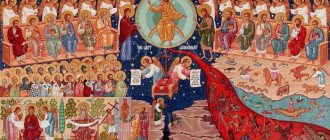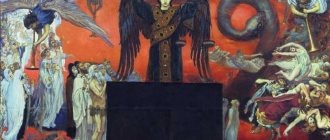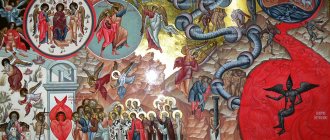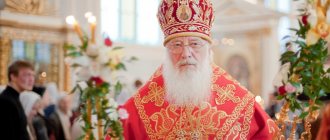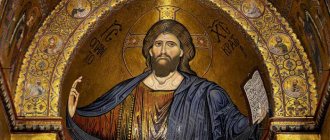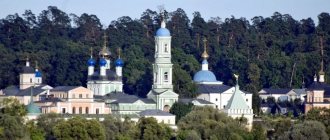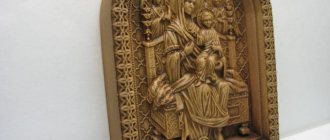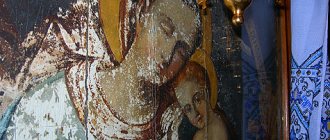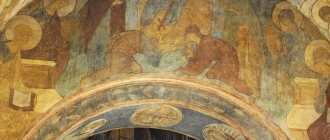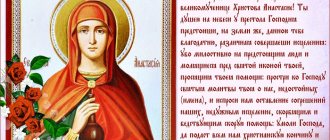Login to the site
Trumpets of the Apocalypse . This is what I would call the images created by Andrei Rublev.
The Last Judgment of the Russian master is very different from its Western European representation with the division of people into righteous and sinners, some of whom fly to the Empyrean, others are cast into hell and terrible torment.
The trumpets of the Apocalypse are not torture or division into good and bad. These are the sounds of fanfare, announcing the meeting of everyone with the merciful Savior. He comes out to meet everyone, inviting them to enter into unity with Him.
From a formidable event, the scene of the Last Judgment turned under the brush of Andrei Rublev into a triumph of philanthropy.
The frescoes are located in the Assumption Cathedral of Vladimir and is a cultural monument taken under the protection of UNESCO.
Looking at the amazing frescoes, comparing them with the paintings of Bosch, you understand how the Russian national character differs from the Western European one with its desire to crush, prevent, destroy, force.
The images of the Last Judgment of the 12th century on the icons and frescoes of that period are equally strict.
Icon "Last Judgment"
“Everyone will be rewarded according to his deeds” was the slogan of what will happen at the end of time. Andrei Rublev lived a hundred years earlier than Bosch (born in 1360) and became the final point in the formation of the image of the Russian national character and the Russian school of icon painting. A distinctive feature of the Rublev school is kindness, love and sacrifice.
God's judgment cannot be fair and righteous, because there is no person who will live and not sin. Judgment can only be the grace of God and nothing else. Mercy at the Last Judgment is much more important and stronger than punishment, more important than the fear of hellish torment that Bosch’s paintings are full of.
“Never say that the Judge is just, because if He were just, we would all be condemned.”
God requires only love and mercy and is Love Himself. What is a person before the forces of nature? A grain of sand, a worm, which will not be difficult to crush. And will God really be so great if he begins to deal with the defenseless? This is not the power of God and He does not expect sinlessness from man. The Day of Judgment for all those resurrected is a meeting, a meeting of the first day of the New World and the New Heaven, a meeting with the merciful Judge.
This is what the Russian icon painter thought when he began painting the western wall of the cathedral. He relied on images of living Russian people with whom he met, talked, who had just overcome the Tatar-Mongol yoke on the Kulikovo Field. The Last Judgment of Andrei Rublev is, first of all, a memory of the departed generations who created the Russian land, a reward for those who will never return from battle.
But this is an appeal not only to those generations that lived before Andrei, but also a look into the future, towards the coming generation that will still live after. The Last Judgment is the expectation of the meeting of all who will rise from their graves on Judgment Day, whom the Earth and Sea will give up, and whom the Savior will meet. This was Andrei’s plan when he began painting the temple vaults.
It was necessary to show the unity and conciliarity of all humanity, an idea taken from Sergius of Radonezh. And he begins. The painting begins with the western arch of the vault under the choir.
At the very top of the arch, Andrew depicts a circle in which is inscribed a huge half-clasped Hand of God, in which the Lord contains the souls of all the righteous.
In the same arch he places King David (to the left of the Hand of God) and the prophet Isaiah (to the right of the Hand of God).
In David's hand is a scroll with words addressed to those who do not fear God's judgment and walk in unrighteous ways, knowing about their atrocities. The king's face is meek and full of concern for them.
The fresco of the prophet Isaiah has not been completely preserved, only his robes and a scroll with words addressed to the stiff-necked Jewish people, whose eyes are blinded, whose ears do not hear, and cannot see the truth, remain.
Below the images of the prophets are depicted archangels with trumpets announcing the resurrection of the dead for the Last Judgment. Under the image of the prophet Isaiah is the Archangel Gabriel with a trumpet raised upward; on the contrary, under King David, with a trumpet lowered to the ground, is the Archangel Michael.
Their trumpet voice is directed in the direction where the Earth and Sea are depicted, giving up their dead to the sound of the trumpet. This calling cry is perceived in different ways. Andrew begins his fresco with this trumpet sound, announcing the beginning of the Judgment.
Under the vault, where the arch is the entrance, Andrei will paint a scene in which not only arches, vaults, walls and their joints will merge in unity, but also the scene of the Last Judgment will appear in complete unity.
The main figure here is “Savior in Power”. Christ seems to be hovering above the heads of those entering under the arches of the temple through an arch with images of archangels. He is depicted on a pure blue background in a mandorla, surrounded by heavenly powers: cherubim and seraphim with kind eyes.
The face of the Savior is kind and does not inspire fear, serious, but not menacing. The Lord is creating a New World and invites everyone to participate in this Creation. His right hand is raised upward in a blessing gesture. The left one is lowered down, indicating the path to the underworld for those who do not want to participate in the creation of the New Earth and the New Heaven. The Lord Jesus Christ is depicted in golden tones, as if cast from gold: a golden halo, luminous golden hair and luminous golden clothing.
Above the Savior are depicted two soaring angels, folding into a scroll the old sky and the obsolete world with the old luminaries, the moon and stars, which must give way to a new and unprecedented kingdom of goodness and light.
Under the image of the Savior there is an image of the throne, the place of Judgment, before which every person will appear. On it lies a large Cross, an instrument of the Lord’s passion, and an open book with the deeds of those resurrected and those who came to the Judgment. Here, at the foot of the throne, the fallen prostrate Adam and Eve are depicted, as an image of redeemed humanity.
On the left and right, according to the iconographic tradition of the Deesis rite, the Mother of God and John the Baptist stand in prayerful poses, begging the Savior to spare the human race for their sins. Behind the Mother of God is the Archangel Michael, behind John the Baptist is the Archangel Gabriel. They are followed respectively by the Apostle Peter and the Apostle Paul.
The archangels, speaking in front of the angels, seem to lead their army, depicted behind the seated apostles. The angels of the southern arch with noble and gentle faces are depicted especially warmly, easily and in a free musical rhythm.
Paul and Peter, depicted separately from the other apostles, also seem to lead the ranks of the apostles depicted on other walls of the vault, on the north and south sides of the arch. On the northern side of the slope are the apostles Andrew, Mark, Luke and Matthew. The last one, on the slope of the eastern arch, we see ap. Philippa.
On the south are Thomas, James, Bartholomew, Simon and John. The faces of all the participants in the Last Judgment (angels, archangels, apostles) express not anger and fear, but a benevolent, bright and calm mood, as if they were going to a meeting that should bring only joy and light.
Apostle Matthew under the brush of Andrew is a quiet and meek old man, who expresses gentleness and disposition towards people.
Luke is depicted as young and determined. He is ready to participate in this Court. Mark awaits the Judgment with a calm expression.
Rublev writes about St. Andrew the First-Called in a special way. According to legend, Andrew the First-Called came to Crimea, to Korsun and went up the Dnieper. At night, at one of the rest stops, he had a dream that there would be a great city here.
This prediction of Andrei came true: Kyiv arose on this mountain. Then he will go north to Novgorod. Rublev's Andrei the First-Called is a strong man with broad shoulders and a strong neck, with a thick round beard, reflecting on what he must witness.
In the arch that leads under the dome, Andrei Rublev will write in a circle four animals, personifying the four kingdoms, after which comes the kingdom of Christ. They are depicted in dynamics, as if they are running in an inner circle, ahead of each other:
bear (Babylonian kingdom), lion (Persian kingdom), panther (Macedonian kingdom) and man-beast (Roman kingdom). But none of them, except the last one, have a predatory expression. An angel points to this circle to the prophet Daniel. Their figures are depicted on the northern side of the vault, at the very bottom
Where the Sea and Earth are depicted giving up their dead, we see righteous women going to judgment. They are depicted opposite the prophet Daniel and the Angel. Their faces do not express fear, they are not waiting for punishment, but for meeting someone for whom they have been waiting for so long, who is joy and happiness for them.
In the southern vault in front of the iconostasis, Andrei Rublev creates the fresco “Procession of the Righteous to Paradise,” which is recognized as a worldwide masterpiece. The righteous are accompanied by Paul and Peter. The apostle of love, Paul, is depicted turning to a crowd of righteous people, as if calling them according to the scroll in his left hand, “Come with me...”.
Nearby, a little lower, is the Apostle Peter with the keys to heaven. In the crowd of righteous people one can distinguish Nicholas the Pleasant and Gregory the Theologian, Savva the Sanctified and Anthony the Great, Basil the Great and John Chrysostom.
Opposite the “Procession of the Righteous to Paradise” is Paradise itself with the forefathers seated in it: Abraham, Isaac and Jacob.
There in paradise, between the fresco “Procession to Paradise” and Abraham’s bed, we see a prudent thief.
Of all the characters in “The Procession...” the face of the Apostle Peter, about whom much has been written, is especially striking. Peter in Andrei’s portrayal is love itself, pure and childlike, trusting and all-forgiving. These are the traits that Andrei Rublev wanted to emphasize as truly Russian: kindness, gentleness, sincerity and openness. It’s as if he bequeathed to all of us to always remain like this, no matter how many centuries have passed: “Be like children...”
Website: In search of peace and peace of mind
